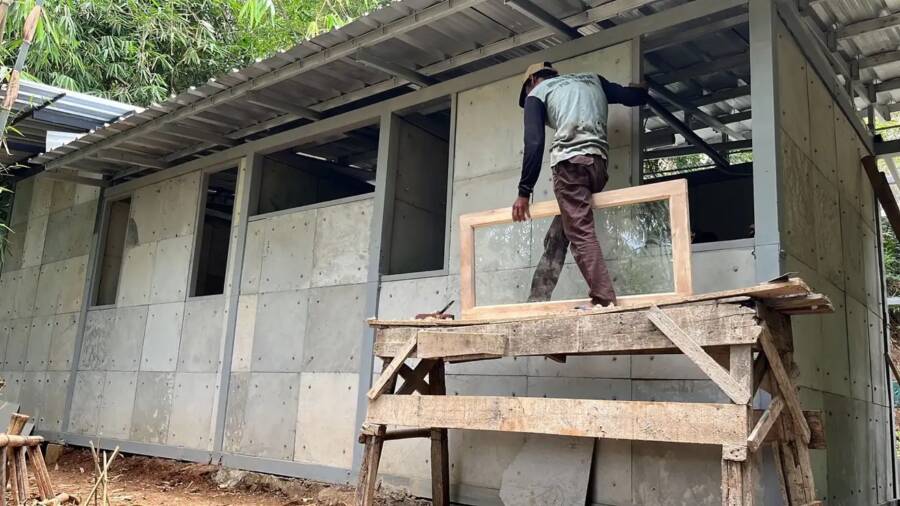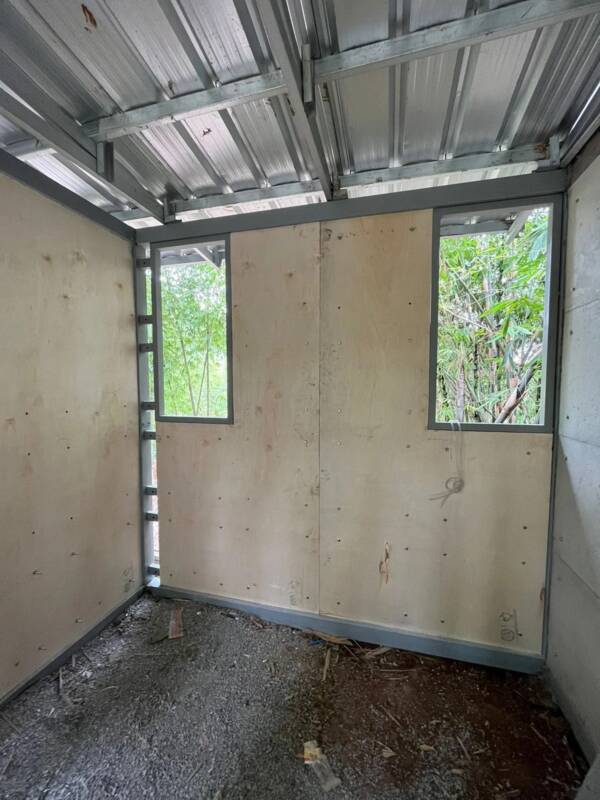Disposable diapers and concrete are both damaging to the environment, but Japanese researchers believe that using diapers to create concrete could solve a portion of that problem.

Muhammad Arief IrfanThe concrete diaper house, complete with an outdoor patio.
Could dirty, disposable diapers be repurposed to create sustainable housing? It’s not a question most people would ask themselves, but a team of engineers from Japan’s University of Kitakyushu have an answer: Yes, it is possible.
Of course, the other question is whether anyone would actually want to live in a house made of diapers.
As Gizmodo reported, the team was able to successfully replace a portion of the sand in conventional concrete with soiled diapers, and by their estimates, roughly eight percent of the sand and mortar needed to construct a single-story home could be swapped out for shredded diapers without it impacting stability or strength.
They published their findings in the journal Scientific Reports, and detailed the process of collecting, cleaning, and repurposing the soiled diapers. As study lead Siswanti Zuraida told Gizmodo, the team processed each of the diapers “manually.”
They removed any solids in the soiled diapers via washing, then neutralized the remaining “offending agents” with a chemical soak, Zuraida explained. Once they were cleaned, the researchers dried and shredded the diapers, then added them into a concrete mixture.
The team created and tested six different mixtures with varying ratios of diaper concrete, focusing on both the microbial content of each and their ability to bear various forces. According to their research, the diaper concrete didn’t contain any more harmful microbes than traditional concrete, nor was it significantly weaker when used in construction.
For non-load-bearing walls, the team estimated that up to 40 percent of the sand used in concrete could be swapped out for shredded diapers, up to 10 percent for columns and beams in a three-story house, and up to 27 percent for columns and beams in a single-story house.
To truly put this to the test, the engineers actually constructed a small, single-story house in Indonesia in which eight percent of all the concrete had its sand swapped out for diaper shreds.
The idea may seem strange, but it is actually a twofold environmental benefit. It removes common, slow-to-degrade items, like diapers, out of landfills and reduces the amount of destructive sand mining required to make concrete.
To put it into context, each year in the United States alone, roughly 4.1 million tons of diapers are discarded. It’s even worse in regions outside the U.S. like Indonesia that don’t have as robust waste infrastructure.

Anjar PrimasetraThe team of engineers constructed a single-story shelter to test the efficacy of diaper concrete.
There’s also a cost benefit. As Zuraida explained, “The recycling process that is available [for diapers] is limited to developed countries because [the technology] is hard to apply and expensive. So it is important to propose a low-cost recycling treatment for diapers in developing countries.”
What’s more, many of Indonesia’s cities are also facing a shortage of affordable housing, and these homes are cheap to build.
But not everyone is convinced that reusing dirty diapers for concrete is a good idea.
“I know nappies are a very big waste problem, but I would never use it in concrete, that’s for sure,” Dr. Rackel San Nicolas told ABC News. “I just cannot imagine how it would be used.”
San Nicolas researches sustainable construction materials at the University of Melbourne in Australia and acknowledged that there are also a number of regulations in the country that would prevent “nappies” from being used in concrete.
But San Nicolas said there are already other ways that concrete makers are able to substitute aggregates and cement itself for waste products to make concrete more sustainable.
One notable substitute is fly ash, a byproduct of burning coal, which can be swapped in for cement and also helps cut down on CO2 emissions.
“We are testing and trying to [prove] more applications where we can use no cement at all, where it’s only fly ash — cement-free concrete basically,” San Nicolas said.

Anjar PrimasetraThe unfinished interior of the diaper house.
There’s also the scale to consider, Zuraida admitted. It’s one thing to build a lone, single-story building out of diaper concrete, but it’s another thing entirely to scale that process to an entire city infrastructure.
“Unfortunately, at this scale, the research has not yet involved waste management and other stakeholders,” Zuraida said.
It would require a ton of planning and work to gather a massive amount of dirty diapers, clean them, and transform them into sustainable building materials, and at this point, that process has not even begun.
Zuraida and her team remain optimistic, though, and plan to move forward with the idea, both improving their methods of collecting and treating the diapers, as well as analyzing the diaper concrete for thermal and acoustic properties to ensure it would be suitable for housing.
After reading about this curious new study, read about how other countries are trying to fight climate change, such as New Zealand’s proposed tax on cow farts. Or, explore this eco-friendly “Hobbit House” in Wales.





